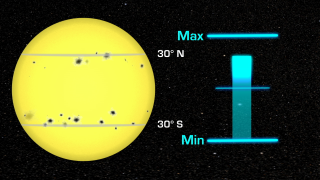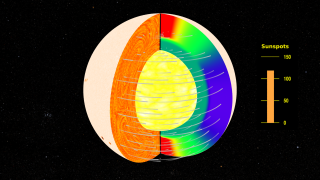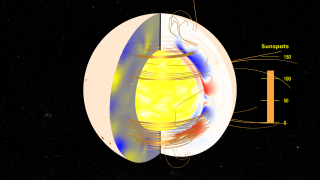The Solar Dynamo: Toroidal and Poloidal Magnetic Fields
In this view of the solar dynamo mechanism, we examine the evolution of the toroidal magnetic field, the field intensity represented by colors on the right-hand cross-section, and the poloidal magnetic potential field, represented by colors on the left-hand cross-section. The poloidal magnetic potential is a scalar quantity that contains information about the radial and latitudinal magnetic field vectors. To see the radial magnetic field, see The Solar Dynamo: Toroidal and Radial Magnetic Fields.
In this visualization, the magnetic field lines (represented by the 'copper wire' structures) are 'snapshots' of the field structure constructed at each time step of the model. These field lines should not be considered as 'moving' or 'stretching' as the model evolves in time.
Even this simplified model reproduces a number of characteristics observed in the actual solar magnetic field.
- Cyclic behavior with oscillations in the magnetic field amplitude.
- Magnetic regions at the surface migrate from high latitudes towards the equator as the solar cycle progresses. This reproduces the "Butterfly Diagram" pattern.
- Surface magnetic polarities reverse with each cycle
Because this model is axisymmetric, it cannot simulate non-axisymmetric features such as active longitudes.










Used Elsewhere In
Related
Visualization Credits
Andres Munoz-Jaramillo (Montana State University): Scientist
Dibyendu Nandi (Indian Institute of Science Education and Research, Kolkata): Scientist
William D. Pesnell (NASA/GSFC): Scientist
Petrus C. H. Martens (Harvard Smithsonian Center for Astrophysics): Scientist
NASA/Goddard Space Flight Center Scientific Visualization Studio
Helioseismic Data Inclusion in Solar Dynamo Models
Short URL to share this page:
https://svs.gsfc.nasa.gov/3521
Mission:
SOHO
Data Used:
SOHO/Michelson Doppler Interferometer (MDI)/Continuum
NASA and ESA - May 1996 to February 2009This item is part of these series:
SDO Pre-launch
Solar Dynamo
SDO - Visualizations
Keywords:
SVS >> HDTV
SVS >> Magnetic Fields
SVS >> SOHO
SVS >> Solar Cycle
SVS >> Solar Rotation
GCMD >> Location >> Solar Interior
SVS >> Hyperwall
SVS >> For Educators
SVS >> Sunspot Cycle
NASA Science >> Sun
GCMD keywords can be found on the Internet with the following citation: Olsen, L.M., G. Major, K. Shein, J. Scialdone, S. Ritz, T. Stevens, M. Morahan, A. Aleman, R. Vogel, S. Leicester, H. Weir, M. Meaux, S. Grebas, C.Solomon, M. Holland, T. Northcutt, R. A. Restrepo, R. Bilodeau, 2013. NASA/Global Change Master Directory (GCMD) Earth Science Keywords. Version 8.0.0.0.0














